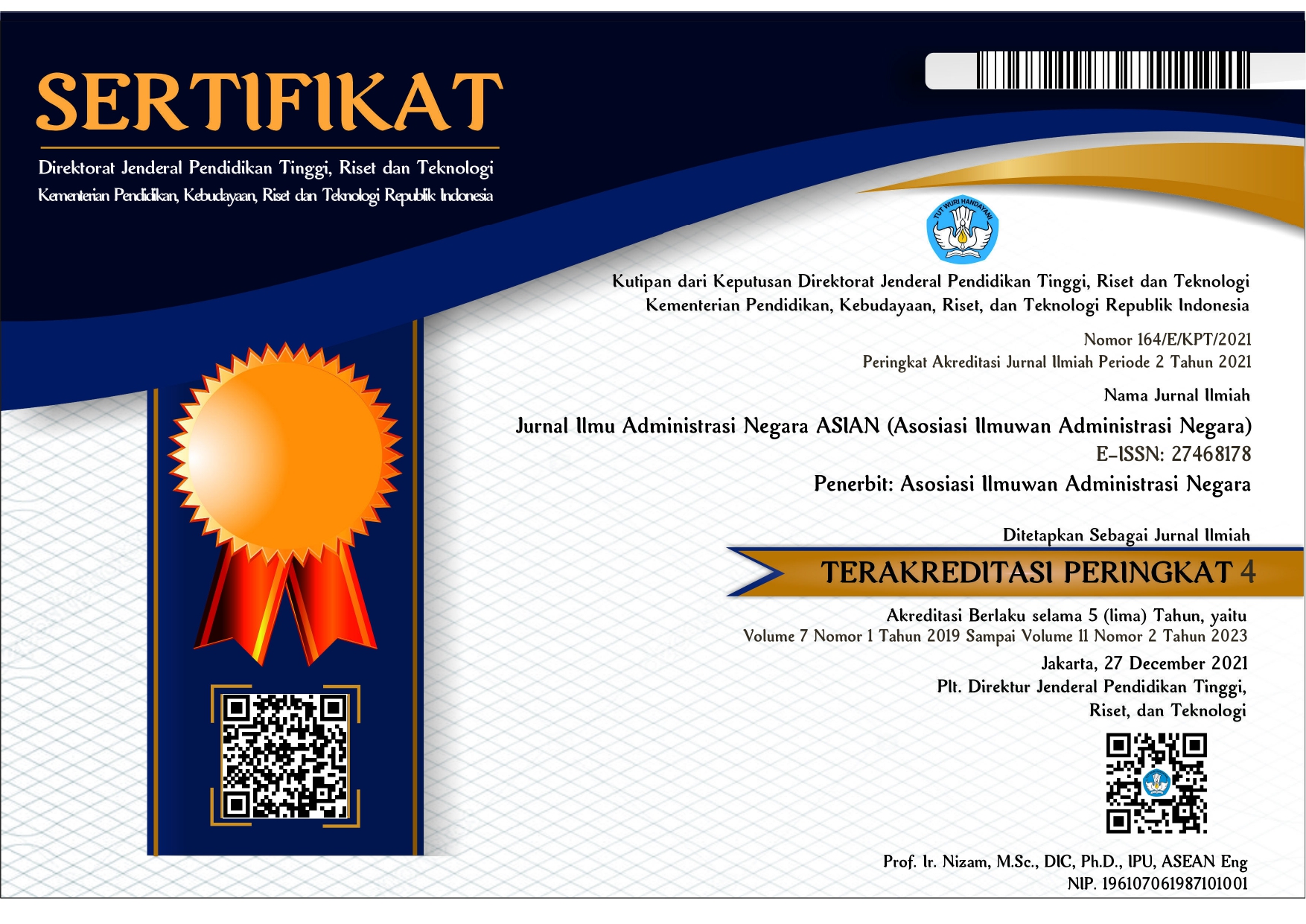Proses Pemilihan Alternatif Kebijakan Daerah
Studi Kasus tentang Komite Ekonomi Kreatif
 Abstract views: 1241
,
Abstract views: 1241
,
 PDF downloads: 1910
PDF downloads: 1910
Abstract
The Banyumas Regency government intends to develop the potential of economy creative in their region through the Banyumas Regent Decree No.050/462/Year 2018 about creative economy committee. In connection with the stipulation of the policy, was reviewed the process of selecting the Banyumas Regent Decree Number 050/462/Year 2018 concerning Banyumas Creative Economy Committee as a regional policy, the election of the Banyumas Regent Decree Number 050/ 462/Year 2018 concerning the Banyumas Creative Economy Committee based on criteria technical feasibility; political viability; economic and financial possibility; and administrative operability, and to find out whether there are other criteria used by the Banyumas Regency Government when determining the Banyumas Regent Decree Number 050/462/Year 2018. The research method used in this study is a qualitative method. The selection of informants uses purposive sampling and snowball sampling. Data is collected through in-depth interviews, observation and documentation. The data analysis method used is an interactive analysis method. To accomplish the validity of the data, the criteria for the degree of trust, transferability, dependability and certainty were used. The results showed that the alternative policy was chosen based on the criteria for selecting the alternative policy: 1) Technical feasibility, it was found that the purpose of establishing KEK was as a forum for ecraf’s actors. 2) Economic and financial, KEK doesn’t receive any special funds and no goals have been achieved. 3) Political viability, this policy doesn’t contradicting with the applicable regulations. 4) Administrative Operability policy is realistic, but the support from the nine offices has not been maximal. 5) The criteria chosen are based on the success of the other regions and then it is adopted. It is the main criteria in the process of selecting and determining KEK as an alternative policy for the development of creative economy potentian in Banyumas Regency
Downloads
References
Anderson, J. E. (2003). Public Policy Making. Boston: Houghton Mifflin Company.
Carta, M. (2007). Creative City: Dynamics, Innovation, Action,. Palermo:list.
Dunn, W. N. (1998). Pengantar Analisis Kebijakan Publik. Yogyakarta: Gajah Mada University Press.
Fahmi, F. Z. (2017). Creative Economy Policy in Developing Countries: The Case of Indonesia. The Case of Infonesia.
Howkins, J. (2001). The Creative Economy. London: Penguin Press.
Islamy, I. (1988). Prinsip-prinsip perumusan Kebijaksanaan Negara. Jakarta: Karunika.
Kariada, N., Martuti, T., Budi, A., Setiawan, & Sumaryanto, T. (2018). Kajian Kebijakan Pemerintah Kota Semarang Dalam Pengembangan Ekonomi Kreatif.
Keban, Y. T. (2004). Enam Dimensi Strategis Administrasi Publik. Yogyakarta: Gava Media.
Moleong, L. J. (2005). Metodologi Penelitian Kualitatif. Bandung: Remaja Rosdakarya.
Neuman, W. (2003). Social Research Methods. Boston: Allyn and Bacon.
Nugroho, R. (2011). Public Policy. Jakarta: Elex Media Komputindo.
Nugroho, S., Susila, I., & Setyawan, A. A. (2018). Surakarta Creative Economy Development Model As An Effort To Create A New Economic Resources.
Pamungkas, R. (2016). Evaluasi Kinerja Kebijakan Sektor Pariwisata dalam mendukung Kota Bandung sebagai Kota Kreatif.
Peters, M. A. (2004). Education and ideologies of the knowledge economy. Europe and Politics of Emulation, Social Work & Society, 162-164.
Sahid, A., Rakhmat, & Kesuma, A. I. (2016). Bureaucracy Accountability in Public Administration at Creative Economy and Tourism Department of Makassar in Indonesia.
Simatupang, T. M. (2019). Perkembangan Industri Kreatif.
Sugiyono. (2009). Metode Penelitian Kuantitatif, Kualitatif dan R&D. Bandung: Alfabeta.
Sulistio, E. B. (2012). Studi Kebijakan Publik. Yogyakarta: Ombak.
Sururi, A. (2017). Inovasi Model Pengembangan Kebijakan Ekonomi Kreatif Provinsi Banten.
Sutopo. (2006). Metodologi Penelitian Kualitatif. Surakarta: UNS.
Toffler, A. (1970). New York: Random House.
UNDP. (2013). Creative Economy Report. widening local developement pathways, 17.
Winarno, B. (2012). Kebijakan Publik. In Teori Proses dan Studi Kasus. Yogyakarta: CAPS.
Dokumen dan Sumber Lain:
Instruksi Presiden Nomor 6 Tahun 2009 tentang Ekonomi Kreatif.
Surat Keputusan Bupati Banyumas Nomor 050/462/Tahun 2018 Tentang Komite
Ekonomi Kreatif.
Copyright (c) 2020 Jurnal Ilmu Administrasi Negara ASIAN (Asosiasi Ilmuwan Administrasi Negara)

This work is licensed under a Creative Commons Attribution-ShareAlike 4.0 International License.
Authors who publish with this journal agree to the following terms:
1. Copyright on any article is retained by the author(s).
2. The author grants the journal, right of first publication with the work simultaneously licensed under a Creative Commons Attribution License that allows others to share the work with an acknowledgment of the work’s authorship and initial publication in this journal.
3. Authors are able to enter into separate, additional contractual arrangements for the non-exclusive distribution of the journal’s published version of the work (e.g., post it to an institutional repository or publish it in a book), with an acknowledgment of its initial publication in this journal.
4. Authors are permitted and encouraged to post their work online (e.g., in institutional repositories or on their website) prior to and during the submission process, as it can lead to productive exchanges, as well as earlier and greater citation of published work.
5. The article and any associated published material is distributed under the Creative Commons Attribution-ShareAlike 4.0 International License









